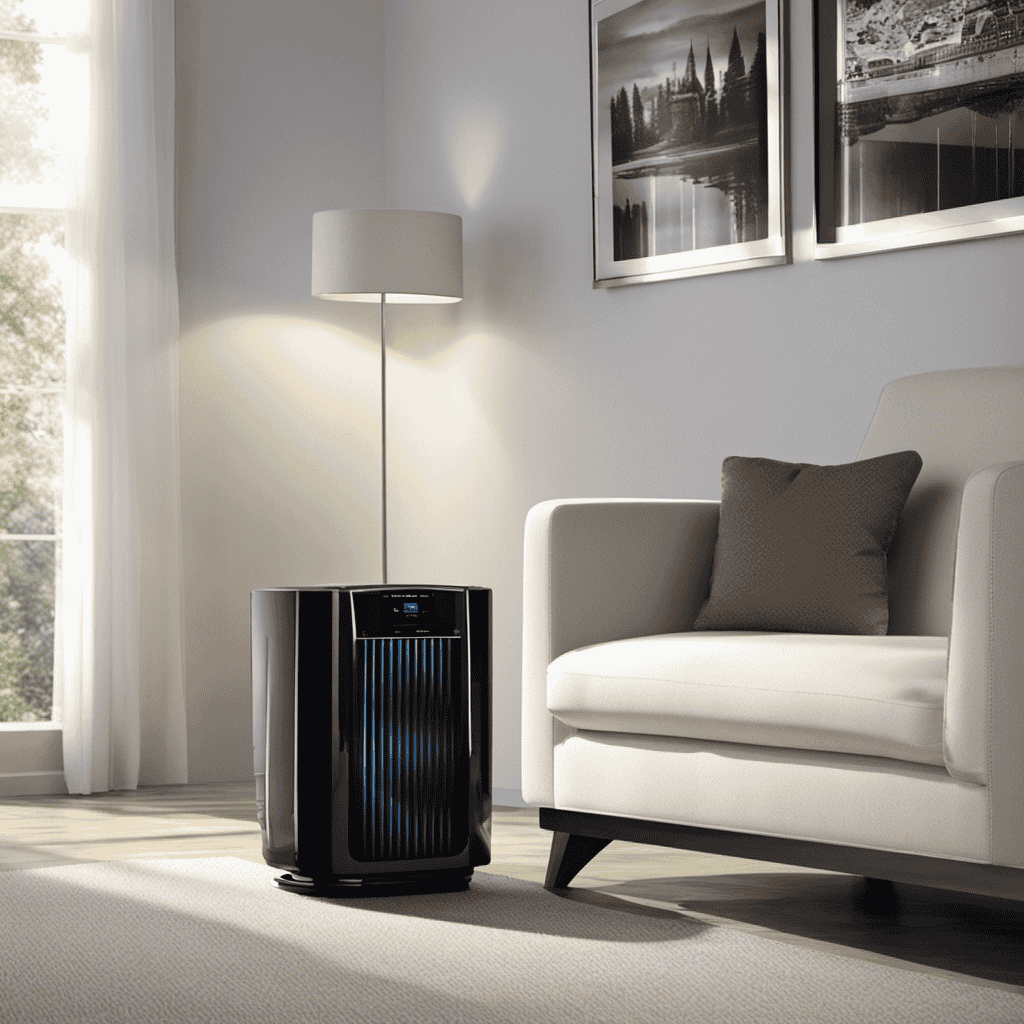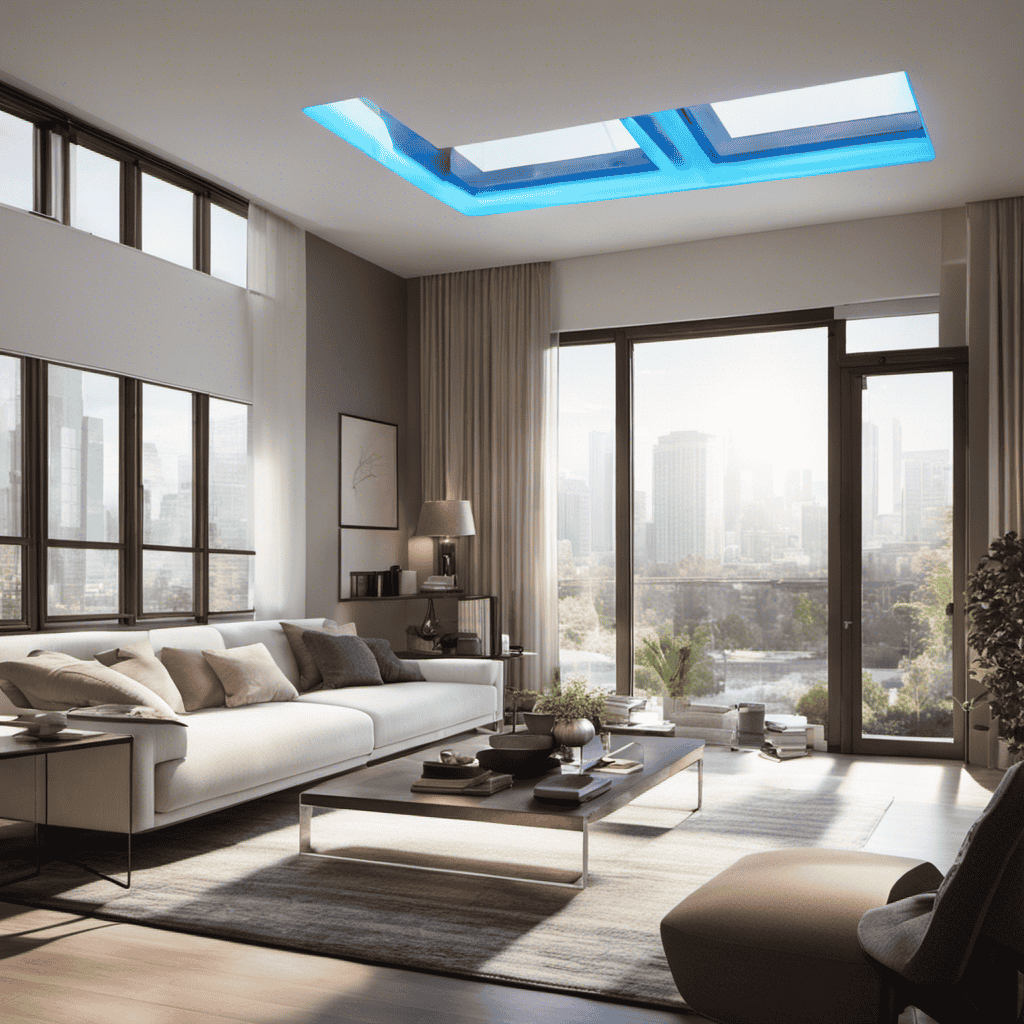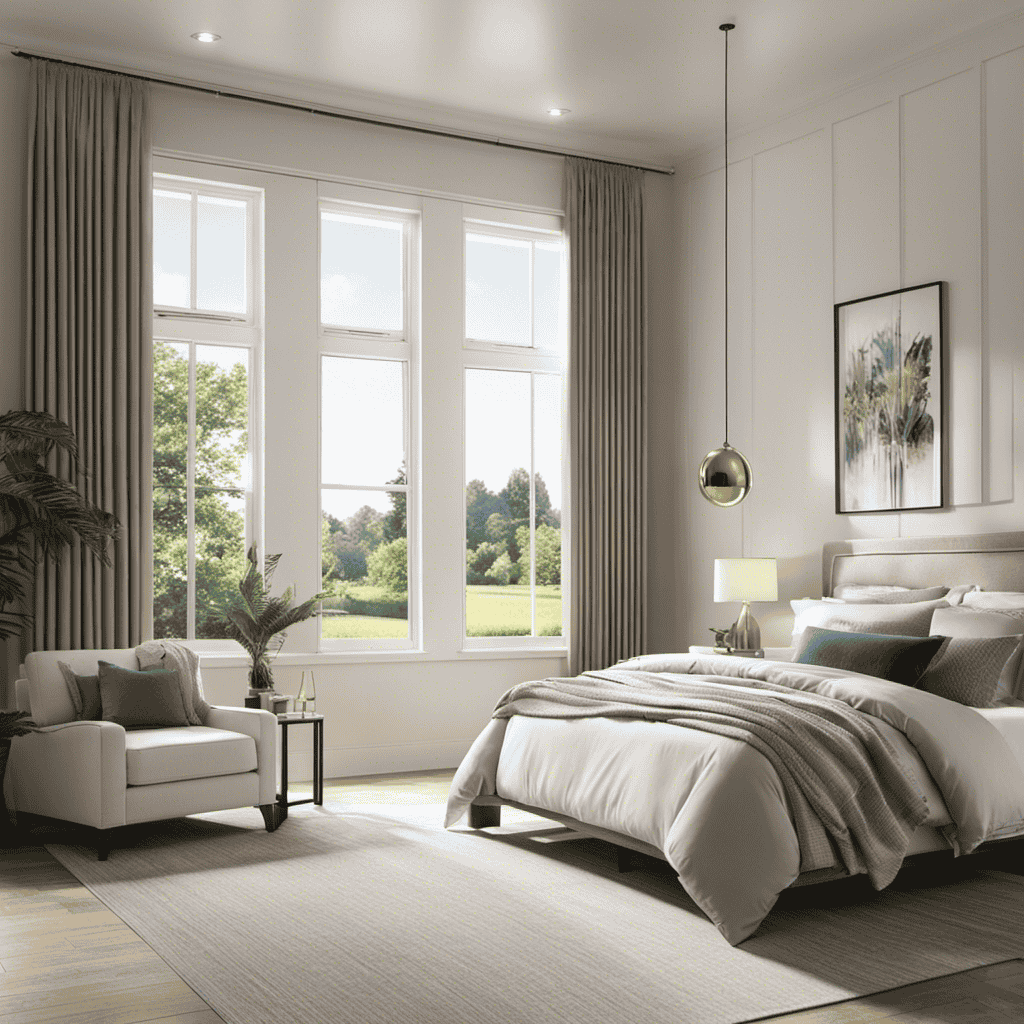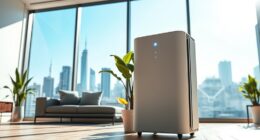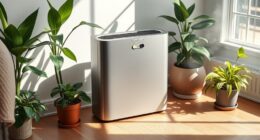As someone who is passionate about air purifiers, I have frequently pondered the ideal height for positioning my device to achieve the best performance.
In this article, we’ll explore the science behind air purifier placement and uncover the ideal height for different scenarios.
Whether you’re looking to combat allergies, eliminate odors, or remove pet dander, we’ll provide evidence-based recommendations to ensure your air purifier is positioned for maximum effectiveness.
So, let’s dive in and discover how high you should place your air purifier for cleaner, healthier air.
Key Takeaways
- Ceiling placement draws in polluted air near the ceiling and releases clean air downwards.
- Floor placement captures pollutants that settle closer to the ground.
- Optimal noise level should be considered when positioning the air purifier.
- Room dimensions and layout determine the size and placement of the air purifier.
Optimal Placement Height
You should place your air purifier at a height that allows for optimal air circulation and coverage.
When it comes to the placement of your air purifier, there are two main options to consider: ceiling placement and floor placement.
Ceiling placement involves mounting the purifier on the ceiling, allowing it to draw in the polluted air near the ceiling and release clean air downwards. This can be particularly effective in spaces with high ceilings or where the majority of pollutants tend to accumulate near the top.
On the other hand, floor placement involves placing the purifier on the floor, allowing it to capture the pollutants that settle closer to the ground. Both options have their advantages depending on the specific needs and layout of your space.
Ultimately, the goal is to position the purifier at a height that allows for maximum air circulation and coverage, ensuring that all corners of the room are effectively treated.
Considerations for Placement
When considering where to position your air purifier, it’s essential to take into account various factors. One important consideration is the optimal noise level. You don’t want your air purifier to be too loud and disrupt your daily activities, so it’s best to place it away from areas where you spend a lot of time, such as your bedroom or living room. Another factor to consider is energy efficiency. Placing your air purifier in a central location can help ensure that the clean air is distributed evenly throughout your home, reducing the need for multiple units and saving energy. To help you visualize the optimal placement of your air purifier, here is a table that outlines the recommended noise level and energy efficiency for different areas of your home:
| Area | Optimal Noise Level | Energy Efficiency |
|---|---|---|
| Bedroom | Low | High |
| Living Room | Low to Medium | High |
| Kitchen | Medium | Medium to High |
| Home Office | Low to Medium | Medium to High |
| Basement | Medium to High | Medium to High |
Considering these factors when positioning your air purifier will help ensure that you are able to enjoy clean, fresh air without compromising on comfort or energy efficiency.
Ideal Room Size for Placement
When it comes to choosing the right air purifier for my home, I have found that considering optimal air circulation, room dimensions and layout, and efficient pollutant removal are key factors.
Optimal air circulation ensures that the air purifier can effectively filter the air in the room, removing pollutants and improving indoor air quality.
Room dimensions and layout play a crucial role in determining the size and placement of the air purifier, ensuring that it can cover the entire space and provide maximum efficiency.
Efficient pollutant removal is essential for addressing specific concerns like allergies or asthma, as it ensures that the air purifier can effectively remove the pollutants that may trigger these conditions.
Optimal Air Circulation
To achieve optimal air circulation, make sure to place your air purifier in an open area away from any obstructions. This will allow the purifier’s fan to distribute clean air throughout the room efficiently.
Here are three important factors to consider when it comes to targeting specific pollutants and maximizing purifier effectiveness:
-
Location: Place the air purifier near the source of pollution for targeted filtration. For example, if you want to reduce allergens in your bedroom, position the purifier close to your bed.
-
Size: Choose an air purifier that is suitable for the room size. Oversized purifiers may waste energy, while undersized ones may not effectively clean the air. Refer to the manufacturer’s guidelines for the recommended room size.
-
Filter Type: Different purifiers come with various filter types, such as HEPA filters for removing particles or activated carbon filters for eliminating odors and chemicals. Select the filter that best addresses your specific air quality concerns.
Room Dimensions and Layout
Consider the dimensions and layout of your room when positioning your air purifier for optimal effectiveness. Room size plays a crucial role in determining the placement of your air purifier.
A larger room may require a higher placement to ensure that the clean air is evenly distributed throughout the space. On the other hand, a smaller room may benefit from a lower placement to maximize the air purifier’s coverage.
Additionally, furniture arrangement should also be taken into account. Placing the air purifier near furniture that obstructs the airflow can hinder its performance. It is recommended to position the air purifier in an open area, away from any obstacles, to allow for proper air circulation.
Efficient Pollutant Removal
An air purifier is most effective at removing pollutants when positioned in an open area with good air circulation. To maximize its efficiency, consider the following:
-
Placement: Position the air purifier at least a foot away from walls or furniture to allow proper air intake and circulation. This will ensure that the purifier can effectively capture pollutants from all directions.
-
Filter Maintenance: Regularly clean or replace the air purifier filters according to the manufacturer’s instructions. This will help maintain the purifier’s effectiveness in removing pollutants from the air.
-
Noise Level: Consider the noise level of the air purifier when choosing its placement. If noise is a concern, avoid placing the purifier in areas where you spend a lot of time, such as the bedroom or living room.
Placement for Allergies and Asthma
When it comes to addressing allergies and asthma with an air purifier, there are several key points to consider.
First, finding the optimal height for the purifier is crucial to ensure effective air filtration.
Additionally, targeting specific problem areas, such as bedrooms or living rooms, can help improve air quality where it matters most.
Lastly, considering airflow circulation is essential in order to maximize the purifier’s efficiency throughout the entire space.
Optimal Purifier Height
To maximize effectiveness, make sure you place your air purifier at a height that allows for proper air circulation in the room.
Here are three important considerations when determining the optimal purifier height:
-
Optimal filter size: The placement of your air purifier affects its ability to filter the air efficiently. By placing it at a height that allows for proper air circulation, you ensure that the purifier can effectively capture airborne particles and allergens. This is especially important if you have a larger space or if you suffer from allergies or asthma.
-
Noise level considerations: Air purifiers can produce varying levels of noise, depending on their design and speed settings. Placing the purifier at a height that is comfortable for you can help minimize any disturbance caused by the noise. Consider placing it at a height that is within your ear level while you are seated or sleeping to reduce any potential disruptions.
-
Accessibility for maintenance: It is important to consider the height of your air purifier for ease of maintenance. Placing it at a height that is easily accessible allows for convenient filter replacement and cleaning. This ensures that your air purifier continues to function optimally and effectively removes pollutants from the air.
Targeting Specific Problem Areas
When it comes to targeting specific problem areas with your air purifier, placement is key. In small spaces, such as bedrooms or home offices, it is recommended to place the purifier on a raised surface, like a desk or shelf, at a height of about 3-4 feet. This allows the purifier to effectively capture airborne particles at the breathing level.
In open concept homes where the air flows freely, it is important to strategically place the air purifier in a central location. This ensures that the purified air can circulate throughout the entire space. Additionally, avoid placing the purifier near walls or furniture that may obstruct the airflow.
To help you visualize the optimal air purifier placement, here is a table summarizing the recommendations:
| Space | Placement |
|---|---|
| Small spaces | Raised surface at 3-4 ft |
| Open concept homes | Central location |
| Obstructions | Avoid walls and furniture |
Consider Airflow Circulation
For optimal airflow circulation, make sure you avoid obstructing the path of the purified air with walls or furniture. Proper placement of your air purifier can have a significant impact on its overall efficiency. Here are three key considerations to keep in mind:
-
Impact of furniture placement: Avoid placing your air purifier behind or underneath large pieces of furniture, such as sofas or cabinets. These can block the airflow and reduce the effectiveness of the purifier. Instead, position it in an open area where the purified air can freely circulate.
-
Effect of room temperature on air purifier efficiency: It’s important to maintain a moderate room temperature for optimal air purifier performance. Extreme temperatures can affect the purifier’s ability to remove pollutants effectively. Avoid placing the purifier near sources of heat or cold, such as radiators or air conditioning vents.
-
Maintain proper distance from walls: To ensure efficient air circulation, keep a reasonable distance between the air purifier and the walls. Placing it too close to the walls can restrict the airflow and limit the purifier’s ability to purify the entire room.
Placement for Odor Removal
The best spot for your air purifier to eliminate odors is near the source of the smells. Placing the air purifier near the source of the odor ensures that the air is filtered directly at the point where the odor is being emitted. This allows the purifier to capture and eliminate the odor-causing particles more efficiently. For example, if there is a specific room or area in your house where the odors are most prominent, it is recommended to place the air purifier in that room or nearby. This way, the purifier can effectively target and remove the odors, improving the overall air quality in that specific area.
Now, let’s discuss the best placement for smoke removal.
Placement for Smoke Removal
To effectively remove smoke from your home, position the air purifier near the area where the smoke is most concentrated. This optimal positioning will ensure that the air purifier can effectively filter out the smoke particles, improving the air quality in your home.
Here are three key factors to consider when placing your air purifier for smoke removal:
-
Proximity: Place the air purifier as close as possible to the source of smoke, such as the kitchen or living room where you tend to smoke. This will allow the purifier to capture the smoke particles before they spread throughout the house.
-
Airflow: Position the air purifier in an area with good airflow, such as near a window or doorway. This will help the purifier to circulate the air and capture the smoke effectively.
-
Height: For smoke removal, it is advisable to place the air purifier at a higher level, as smoke tends to rise. This will enable the purifier to intercept the smoke particles more efficiently.
By following these positioning guidelines, you can ensure optimal effectiveness in smoke removal and create a healthier indoor environment.
Now, let’s discuss the next section about ‘placement for pet dander removal’.
Placement for Pet Dander Removal
When positioning your air purifier to remove pet dander, consider placing it in areas where your pets spend the most time, like the living room or bedroom. By strategically placing the purifier in these locations, you can effectively control pet dander and minimize its impact on your indoor air quality. To further enhance the effectiveness of your air purifier, make sure to choose an ideal location that allows for proper air circulation. This will ensure that the purifier can efficiently capture and remove pet dander particles from the air.
Here is a table highlighting some key factors to consider when determining the ideal purifier location for effective pet dander control:
| Location | Benefits | Drawbacks |
|---|---|---|
| Living room | Central area where pets often gather | May not cover entire home |
| Bedroom | Promotes better sleep by reducing pet dander | Limited to one room |
| Pet’s favorite spot | Targets the area where pets spend the most time | May not address pet dander in other areas of the home |
Placement for Dust and Pollen Removal
When it comes to targeting specific problem areas like dust and pollen, the optimal placement height for an air purifier is crucial. Here are three key considerations to keep in mind:
-
Tabletop height: Placing the air purifier at tabletop height, around 2-3 feet off the ground, is ideal for capturing dust and pollen particles that tend to settle closer to the floor. This height allows for effective filtration and purification in the lower areas of the room.
-
Near problem areas: Identify the areas in your home where dust and pollen concentrations are highest. Placing the air purifier near these problem areas, such as windows or doorways, can help remove airborne particles before they spread throughout the room.
-
Proper airflow: Ensure that there is enough space around the air purifier for proper airflow. Placing it too close to walls or furniture can hinder its ability to circulate and capture dust and pollen effectively.
Placement for Maximum Air Circulation
For optimal air circulation, it’s important to consider the placement height and location of your air purifier. To maximize the effectiveness of your purifier, it is recommended to place it at a height that allows for the most efficient distribution of clean air throughout the room.
Generally, placing the air purifier at a height of about 3 to 5 feet above the ground is ideal. This allows the purifier to capture pollutants at their source, such as dust and allergens that tend to settle closer to the ground. Additionally, ensure that the purifier is placed in an open area, away from walls or furniture that may obstruct air flow.
In terms of the size of the air purifier, it is important to choose one that is suitable for the room size. A purifier that is too small may not be able to effectively clean the air, while a purifier that is too large may not be as energy-efficient. The optimal purifier size can be determined by considering the square footage of the room and the Clean Air Delivery Rate (CADR) of the purifier. The CADR indicates how quickly the purifier can clean the air, so choosing one with a CADR that matches the room size ensures optimal air purification.
In order to maintain the effectiveness of your air purifier, it is important to follow a recommended maintenance routine. This typically includes regularly replacing the filters, as they can become clogged with pollutants over time. The frequency of filter replacements may vary depending on the purifier model and usage, but a general guideline is to replace the filters every 6 to 12 months. Additionally, it is recommended to clean the exterior of the purifier regularly to remove any dust or debris that may accumulate.
Frequently Asked Questions
Can I Place My Air Purifier on the Floor?
Yes, you can place your air purifier on the floor. However, it is generally recommended to elevate it a few feet above the ground to maximize air circulation and ensure optimal purification.
Should I Place My Air Purifier Near a Window?
Yes, you can place your air purifier near a window. It helps to improve air circulation and can reduce indoor air pollutants. However, avoid placing it near a door or in the kitchen where there may be higher levels of pollutants.
Can I Place My Air Purifier in a Corner of the Room?
I can place my air purifier in a corner of the room, but it’s not the optimal placement. According to experts, placing it higher, away from walls and furniture, ensures better air circulation and filtration.
Is It Necessary to Have Multiple Air Purifiers in a Large Room?
It’s not necessary to have multiple air purifiers in a large room. One efficient air purifier placed strategically can effectively remove different pollutants. Factors to consider include room size, CADR rating, and filtration technology.
Can I Place My Air Purifier on a Shelf or Bookcase?
I can place my air purifier on a shelf or bookcase, but it’s important to consider the benefits of having it at the right height for maximum efficiency. Here are some tips for choosing the right air purifier for your home.
Conclusion
In conclusion, when it comes to placing your air purifier, there are a few key factors to consider.
The height at which you place it should be at least 3 feet off the ground to ensure maximum air circulation.
Additionally, it’s important to consider the size of the room and the specific needs you have, whether it be allergies, asthma, odors, smoke, pet dander, or dust and pollen.
Interestingly, studies have shown that placing an air purifier in the bedroom can result in a 49% reduction in airborne allergens, providing a healthier and more peaceful sleep environment.



